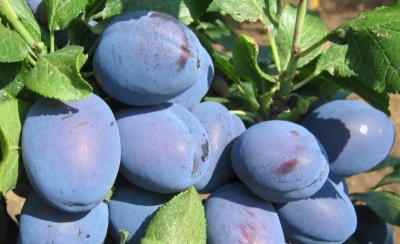
- Authors: Germany
- Appeared when crossing: Chachak Naibolia x President
- Growth type: medium-sized
- Crown: medium density
- Fruit size: large
- Fruit weight, g: 100
- Fruit shape: ovoid
- Fruit color: dark purple
- Pulp (consistency): juicy, dense
- Pulp color : yellow
Homemade plum Top Gigant is one of the largest-fruited plants growing in Russia. It gives bountiful harvests, responds well even to minimal care. A plum orchard made of such plants will become a real decoration of the estate and will have good commercial prospects for growing fruits for sale.
Breeding history
A variety of German selection. Obtained by crossing the varieties Chachakskaya Naiboliya and President in 1995. Not officially entered into the state register of the Russian Federation.
Description of the variety
The trees are medium-sized, with a medium-dense crown. Strong, with well-developed shoots, do not need support, even under the weight of a large crop. The height of the trunk can reach 4 m. The branches grow sparsely, sunlight passes well through the crown.
Fruit characteristics
Fruits are strong, ovoid, transportable. Each plum is large in size, reaching a weight of 100 g. The skin is colored dark purple. Has a noticeable bluish bloom. The pulp is yellow, with a dense consistency not subject to creasing, adapted for long-term storage. The bone is well separated from it.
Taste qualities
The fruits are very sweet and juicy. The taste is pleasant both fresh and processed. Slight acidity in the shade makes it more balanced.
Ripening and fruiting
The variety begins to bear fruit for 3 years. Harvesting takes place in August. In regions with a temperate and cold climate, fruiting occurs in the 2nd decade of September.

Yield
Ripe plums can be obtained in volumes up to 60 kg from 1 tree. The variety is considered to be high yielding.
Growing regions
The Top Gigant variety is perfect for growing in the Moscow region, in Central Russia. It winters well in the Urals and Siberia, but may not have time to fully bear fruit in regions with short summers.
Self-fertility and the need for pollinators
Top Giant is a self-fertile variety. Flowering occurs in May. Planting a number of plum trees or cherry plums with similar budding times will increase yields and give interesting shades to the taste of the fruit pulp.
Growing and care
Planting is recommended in the spring, from March to May. The soil is selected loose, well-drained, moist. It is pre-dug up, fertilized abundantly, mixing the infertile soil layer with nutrients. For each pit, in addition to compost or humus, 150 g of phosphates and 70 g of potassium salt should be added.
A retaining peg is installed in each hole. The tree is buried in the ground from the north of it. Plants are placed 5-6 m apart. It is not required to deeply bury it. After planting, the tree is watered abundantly.
It is important to pay attention to the fact that Top Giant responds well to watering and feeding. It is not worth saving on water during the season; in the first years in summer, watering should be weekly.But feeding will be needed only from the 3rd year. Plants in the spring will respond well to nitrogen fertilizers, phosphorus and potassium will have a good effect on the state of the tree during flowering and fruiting.
Formative pruning is an important part of the successful cultivation of this plum variety. Trees in the first years of their development show very rapid growth. It will be useful for them to remove shoots directed inside the crown. In the spring, after wintering, a thorough thinning is also carried out, removal of broken, dead shoots from the crown.




Disease and pest resistance
Trees are well protected from pest attacks. Fungal diseases and viruses are also not too scary for them. The variety is resistant to shark, which is harmful to plums.

Despite the fact that plum is considered more hardy than many fruit trees, it is not immune from diseases. It is attacked by viral, fungal and bacterial infections, and parasitic insects harm it. It is necessary to notice and recognize the signs of plum disease in time. They are easier to deal with and defeat early on. Well, in order to protect the garden tree from such a misfortune in the future, preventive procedures can be carried out.
Resistance to soil and climatic conditions
The Top Gigant variety is winter-hardy, with high resistance to low atmospheric temperatures. Trees are shade-tolerant, they can be planted not only in the sun. In the spring, trees of the first years of life are recommended not to be opened too early. During periods of return frosts in the spring, they also need attention, otherwise the flowers may be discarded.

Review overview
Having barely appeared in Russia, the Top Gigant plum easily acquired many loyal fans. The variety is practically devoid of flaws, bears fruit abundantly, and is not capricious in planting. Preserves and jams, sauces from these plums are very popular. Fresh fruits are also very tasty. The trees themselves grow quickly and are easy to keep in order when pruning.
The discontent of summer residents is only caused by the difficulty of buying a high-quality seedling. In addition, in difficult climatic conditions, it is better to immediately plant other varieties of plums nearby for improved pollination. This will increase the chances of getting a bountiful harvest.


































































